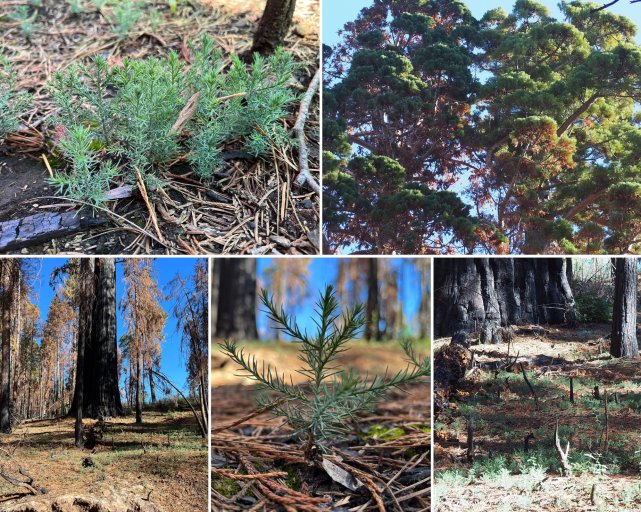Arnold, CA…California State Parks today announced that the two monarch giant sequoias known as “The Orphans” at Calaveras Big Trees State Park are alive and no longer stand alone. The sequoias were damaged during a prescribed burn in the park’s North Grove area last fall. Several scientists visited The Orphans on Thursday, October 5, and observed that they are alive and thousands of giant sequoia seedlings now surround them.

“Standing beneath these magnificent trees and seeing the carpet of baby seedlings is incredible,” said California State Parks Central Valley District Superintendent Danielle Gerhart. “Sequoia regeneration is one key forest management goal in Calaveras Big Trees State Park, and witnessing the results of the burn program through this new growth shows the importance of fire in the ecosystem. State Parks will continue to work to protect and preserve this land using many different tools and the latest science to manage the resources in the park.”
One of the scientists who visited the North Grove is Kristen Shive, assistant cooperative extension forest and fuels specialist at the University of California, Berkeley. “It was also heartening to see that The Orphans have survived and that there are so many seedlings at their base,” said Shive.
Out of these young seedlings currently battling to survive, only a few will become the next generation of giants. The Orphans and the new seedlings demonstrate giant sequoia resilience, fire dependence and adaptation. To protect the future of these seedlings and the North Grove, the public can help by remaining on the trail to avoid trampling the new growth.
Prescribed fire is an important forest management tool that returns fire to the ecosystem and reduces the risk of catastrophic wildfires. Giant sequoias cannot naturally reproduce in large numbers without fire. The heat from fire opens cones and helps release seeds. Fire kills competing trees and other plants. This mortality opens the forest, creating gaps in the forest canopy and allowing sunlight to reach the seedlings on the forest floor. Fire also returns nutrients to the soil and creates a mineral soil seedbed, which giant sequoias require to germinate.
In spring 2023, State Parks identified that The Orphans, named by early California immigrants, had suffered significant scorch from heat during the 2022 prescribed burn.
“Sometimes there are minimal losses of ancient trees even in a restorative prescribed fire,” said Shive. “Giant sequoias are not museum pieces, and some mortality is part of this living, dynamic ecosystem. But the potential for minimal losses in prescribed fire is far preferable to the thousands of ancient trees that were killed in 2020 and 2021, when fuel-loaded forests burned in severe wildfires. It’s great to see the park relying on the best available science to protect these incredible trees.”
The State of California through the Wildfire and Forest Resiliency Program (WFRP) provides funding for prescribed burning. WFRP expands on critical land management that California State Parks has been carrying out for decades and supports increasing the pace and scale of fuels treatments so that California’s State Park System can become an example of resilient ecosystems maintained through active stewardship.
State Parks and CAL FIRE crews recently came together to show how a controlled burn can improve wildlife resiliency at Calaveras Big Trees State Park. Click here to view a video, where forestry and park experts explain why reintroducing fire to the giant sequoia landscape is key.
Thousands of giant sequoias seedlings now surround the two giant sequoias, “The Orphans,” in the North Grove of Calaveras Big Trees State Park. Photos from California State Parks.
###
The California Department of Parks and Recreation, popularly known as State Parks, and the programs supported by its Office of Historic Preservation and divisions of Boating and Waterways and Off-Highway Motor Vehicle Recreation provide for the health, inspiration and education of the people of California by helping to preserve the state’s extraordinary biological diversity, protecting its most valued natural and cultural resources, and creating opportunities for high-quality outdoor recreation. Learn more at parks.ca.gov.


